January, 2006:
This partlet is based on Vecellio's Fig 183: Young
Florentine woman married for some years, Fig 184 Obsolete
Street Dress of Florentine girls and Vincenzo Campi's The
Fruit Seller (1580's). All three can be seen below. The first two
are Florentine examples. The third is not.
The first example is the main example I am using to base this
partlet on.
Pattern, Construction and Materials:
Each has a front opening. Looking closely at the first example, it
appears that there is bias along the front opening. This is
consistant with examples in the 16th century. Some of these can be
found in Janet Arnold's Patterns of Fashion. One example is
found on page39 Fig 275 & 278; bias binding edge with hem
stitched on. I bound the front opening with bias I made from
linen.
The collar will be made in one rectangular piece, as each example
does not appear to have a 'fitted' look. Examples of collars made
from this pattern can also be seen in Patterns of Fashion
(1570-80 Woman's loose gown).
As this partlet will not necessarily be worn with a high neck
doublet to support it, I decided to 'stiffen' the collar. One common
method was using layers of linen. I have used this method for
Dafydd's Rapier doublet.
|
Right: oringally from
http://www.tudor-portraits.com/Costumes.htm and from
Tribute to Janet Arnold at the V&A Museum - found
at: http://www.kipar.demon.co.uk/arnold.html This
example of a 16th century rapier doublet shows the stitching
to hold layers of linen and wool to stiffen the collar.
Patterns of Fashion also shows a doublet lining
on collar layers of course linen (p16 Fig 174)
I used four layers of linen, herringbone stitched and
inserted in the collar.
|
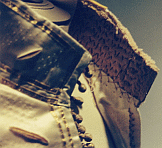
|
Again, looking at the Vecellio drawing, the attatched ruffs
are of a reasonable depth possibly 2-3 inches and appear to be very
flat at the collar seam. I used box pleating to give the full
appearance and keeping it flat along the collar seam. The ruff was
sewn to the collar by using running / stab stitches after
'sandwiching' the ruff into the two part collar.
Examples of this construction method can be found in Patterns
of Fashion, these being:
- p15 Fig 84 shows stab/running stitches in collar and doublet
front opening, which is folded over with the bias inserted between
- p18 Fig 106 Collar of Nils Sture's leahter doublet shows a
similar construction method to put the 'ruff' on the collar
- p28 Fig 185 shows similar construction of collar and ruff.
- p39 Fig 276 shows similar construction of ruff on the bottom
of sleeve with bias decorations.
Sewing Stitches Used in Medieval Clothing quotes examples
of running stitch specifically used in Florentine clothing - 1562
Florence, Italy Suit of Cosimo I de’Medici. Raw edge of silk on panes
on trunkhose turned under and held by running stitches in 2-ply silk
Arnold, Patterns, pp. 53-54. Stab stitch 1562 Florence, Italy Suit of
Cosimo I de’Medici. Row of stab stitches down center front about
1.5mm (1/16") from edge Arnold, Patterns, pp. 53-54. This is similar
in construction as I have used for the collar.
The collar 'lining' was hemstitched to the body of the partlet.
eg.upright Hem stitch 1562 Florence, Italy Gown and pair of bodies
worn by Eleanor of Toledo. Slanted and upright hem stitching used.
Arnold, Patterns, p. 102 . and Overcast stitch1562 Florence, Italy
Gown and pair of bodies worn by Eleanor of Toledo. Linen lining of
bodies attached to velvet by overstitching Arnold, Patterns, p. 102
Seams were handsewn in backstitch with the seams being flatfelled
(see Archeological sewing and Tudor
Tailor - smocks).
I added ties at the front collar, as at the collar, in the Campi
portrait, to allow the collar to be closed when required. The ties
were hand-knitted with cotton cord.
I will be using left over 'cabbage' linen, from previous projects.
Decoration:
In the Vecellio drawing, the partlet appears to have embroidery on
the inside of the collar. The second example has embroidery on the
main part of the partlet and possibly on the collar as well. Both are
consistent with noble clothing. (the embroidery would only be
afforded by the rich) The third is very plain, as it is a worker.
As many who follow my diaries will know, I like pomegranates! In
Embroidery: Early 16thCentury, I found this following pattern
(left) and have adapted it for the embroidery on the collar (right)
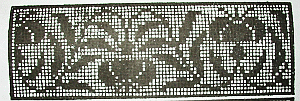
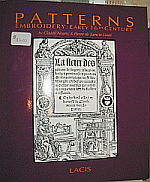
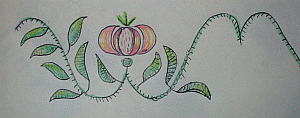
I used mainly split stitch and this will be my first real try at
'shading' with split stitch. A good article on this can be found at
the Bayrose
website. This will be executed in Madera silk thread. The
following stitches were used for multi-coloured embroidery on linen
in the 16thC, split, stem, chain, back, cross and speckling stitches.
Examples of these stitches can be found at Bayrose's Database of
Stitches from Extant Textiles, Queen Elizabeth's Wardrobe
Unlock'd and Blackwork.
22 January, 2006 - 8th Feb, 2006.:
The Collar Embroidery:
|
This was done in chain
stitch, for the vine, with split stitch to paint the leaves
and pomegranites.
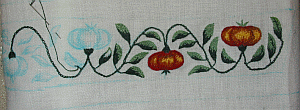
|
Finally the collar embroidery is finished 
|
Construction:
This partlet was hand sewn using backstitch and flat felled seams
with running stitch for overstitching. This is consistant with
information found in both Archeological sewing and in Tudor
Tailor.
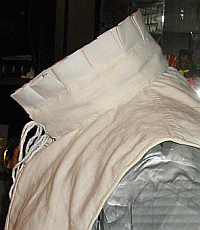
|
|
|
The final collar standing with linen layers
|
the final collar on the embroidered side and the
outside
|
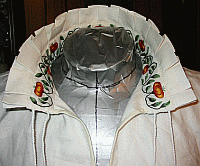 The cords are hand-knitted from cotton thread. The final partlet from the front.
The cords are hand-knitted from cotton thread. The final partlet from the front.
Bibliography
- Arnold Janet,
Queen
Elizabeth's Wardrobe Unlock'd, Maney, Leeds, 1988, ISBN:0-901286-20-6
- Archive of
Stitches from Extant Textiles. www.bayrose.org
- BayRose. (website by Savinra de la Bere.)
http://www.bayrose.org/needlework/Shading-1.pdf
- Crowfoot E,
Pritchard F & Staniland K, Textiles and Clothing 1150-1450,
Boydell Press, Woodridge, 2001 (ed) ISBN: 0-85115-840-4
- Festive Attyre:
http://homepage.mac.com/festive_attyre/
- Frick, Carole
Collier. Dressing Renaissance Florence.: Families Fortunes &
Clothing. John Hopkins University Press. Baltimore. 2002. ISBN:
0-8018-6939-0
- Kovesi Killerby,
Catherine,
Sumptuary Law in Italy 1200-1500, Oxford University Press. NY.
2002. ISBN:0-19-924793-5 .
- Nourry, Claude &
de Saincte Louie, Pierre. Patterns Embroidery: Early 16thCentury.
Lacis.
Berkley. 1999. ISBN: 1-891656-16-3
- Snook, Barbara,
English Embroidery, Bell & Hyman, London, 1974
- Veccellio,
Cesare.
Vecellio's renaissance Costume Book. Dover Publications. NY. 1977.
ISBN: 0 48623441X
- Sewing Stitches
Used in Medieval Clothing Compilied by Jennifer L. Carlson
http://www.personal.utulsa.edu/~marc-carlson/
- Archeological
Sewing by
Heather Rose Jones (2001)
www.virtue.to/guest_authors/archaeological_sewing.html (5/04)
- Mikhaila, Ninya &
Malcolm-Davies, Jane. The Tudor Tailor: Reconstructing sixteenth
-century dress. BT Batsford, London. 2006. ISBN:0 7134 8985
5
- Orsi Landini, Roberta
& Niccoli, Bruna. Moda a Fioenze 1540-1580. Pagliai Polistampa, Firenze,
2005. ISBN: 88-8304-867-9
© K Carlisle. 2006- 2008

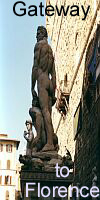




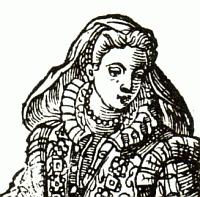
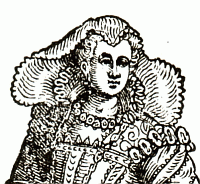
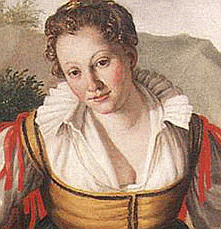



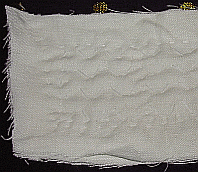
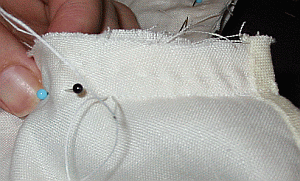
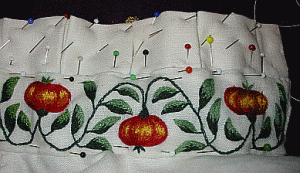



 The cords are hand-knitted from cotton thread. The final partlet from the front.
The cords are hand-knitted from cotton thread. The final partlet from the front.